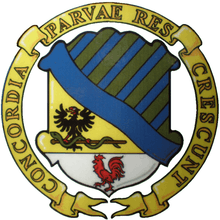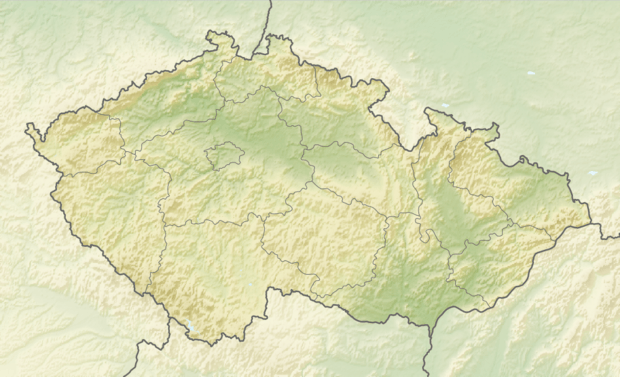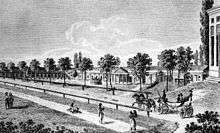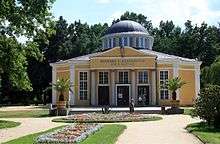Františkovy Lázně
Františkovy Lázně ([ˈfraɲcɪʃkovɪ ˈlaːzɲɛ] (![]()
Františkovy Lázně | |
|---|---|
Town | |
 Casino | |
 Flag  Coat of arms | |
 Františkovy Lázně Location in the Czech Republic | |
| Coordinates: 50°7′14″N 12°21′7″E | |
| Country | Czech Republic |
| Region | Karlovy Vary |
| District | Cheb |
| First mentioned | 15th century |
| Government | |
| • Mayor | Jan Kuchař |
| Area | |
| • Total | 25.74 km2 (9.94 sq mi) |
| Elevation | 442 m (1,450 ft) |
| Population (2019-01-01[1]) | |
| • Total | 5,514 |
| • Density | 210/km2 (550/sq mi) |
| Time zone | UTC+1 (CET) |
| • Summer (DST) | UTC+2 (CEST) |
| Postal code | 351 01 |
| Website | www |
Geography
The town is located in the Chebsko (formerly Egerland) region near the border with Germany. It is situated in the Ohře river basin, north of the regional capital Cheb (Eger).
The municipal area comprises the cadastral communities of Dlouhé Mosty, Františkovy Lázně proper, Horní Lomany, Jedličná, Krapice, Slatina u Františkových Lázní, and Žírovice.
History
The salutary effects of the surrounding springs were known from the late 14th century on. The physician Georgius Agricola (1494–1555) mentioned the mineral water available to Eger citizens. The sources from which, according to ancient law, water was drafted and brought to the city, were first used locally for salutary purposes. Later, the water was also shipped in earthenware bottles and in 1700, it reportedly sold more water than all other spas in the Empire combined. About 1705, an inn was erected at the site of a mineral spring later known as Franzensquelle.

In 1793, the town was officially founded under the name Kaiser Franzensdorf, after Emperor Francis II (German: Franz II), and later renamed Franzensbad, under which name it became a famous spa (Bad). The spa was founded by Eger-based doctor Bernhard Adler (1753–1810).[2] He promoted the expansion of spa facilities and the accommodation for those seeking healing and promoted the transformation of the swampy moorland with paths and footbridges to well-known sources.
When in 1791 Adler had a pavilion and a water basin erected at the Franzensquelle, he sparked the Egerer Weibersturm ("Women's storm of Eger") by numerous women who earned their livelihood in the scooping, transport and sale of the water in Eger. Feeling their water-bearing rights threatened, they demolished his premises.[3]
The town council of Eger intervened and made the extension of Franzensbad as a health resort possible.[4] The result was an extensive recreation area, with easy access from the city of Cheb. Johann Wolfgang von Goethe was one of the most famous guests in the early days; his visits to Franzensbad with Johannes Urzidil were extensively reported in the book Goethe in Böhmen (1932, revised 1962 and 1965). Another famous visitor was Ludwig van Beethoven, who was accompanied by Antonia Brentano and her family.
.jpg)
During the 19th century, patients included numerous aristocrats, especially Russian nobles, and at the same time widely known doctors bolstered the reputation of Franzensbad as a therapeutic resort. Franzensbad offered one of the first peat pulp baths in Europe, popular especially with female guests. A public spa house was built in 1827. The writer Marie von Ebner-Eschenbach portrayed her stay in her early work Aus Franzensbad in 1858. Other notable guests included Theodor Herzl (in 1904), Emperor Francis Joseph I of Austria and Archduke Charles I of Austria.
In 1862, Franzensbad became an autonomous municipality and obtained town privileges three years later. Until 1918 it was part of the Bohemian crown land of the Austro-Hungarian monarchy.
After World War I, the town's reputation began to fade. Then part of the new state of Czechoslovakia, the spa lost much of its patronage and was hit hard by the Great Depression of 1929.
After World War II, the German-speaking population was expelled under the Beneš decrees; many of them settled in Bayreuth in the German state of Bavaria. The spa, officially renamed Františkovy Lázně in Czech, was nationalized under the rule of the Communist Party. After the Velvet Revolution of 1989, a stock company was established to revive the status of Františkovy Lázně as a venue for international guests.
Spa

The local natural mineral water has a relatively high content of dissolved carbon dioxide. The effects of the carbonic baths are shown in the better performance of the cardiovascular system, in the mild decrease of blood pressure in the pulse, in the lower occurrence of chronic inflammatory processes in the body, and also in terms of rheumatics, and in the improved blood circulation in tissues and the vegetative stabilisation.
The local mud treatments represent a traditional curative method which has thermal, chemical and mechanical effects. The mud treatment consists of a thick mushy combination of mud and mineral water which is heated up to a temperature which is significantly higher than body temperature. The treatment has a positive effect on mobility of muscles and the pain in treated tissues.
The local spa corporation is the biggest spa corporation in the Czech Republic.. It operated 24 mineral springs, 12 of which are still in operation.
Culture
The townscape of Františkovy Lázně is largely shaped by neoclassical and Belle Époque buildings of the Habsburg era, as well as by extended parks and gardens with numerous springs and bathhouses.
Leisure and entertainment
The Social House is the venue of congresses, balls and other social events and the building also houses a casino.
Galleries and museums
- Town museum 50.1215756°N 12.345736°E
- AUTO MOTO MUZEUM (Colonnade of Salt and Meadow Spring)50.115626°N 12.355770°E
Arts and literature
- Theater Boženy Němcové50.1197255°N 12.3539244°E
Notable people
- August Brömse (1873–1925), Bohemian-German painter
- Peter Jacques (born 1935), Swiss jazz musician
- Ferdinand Khittl (1924–1976), German film director and screenwriter
- Josef Löbel (1882–1940?), German-Bohemian physician and writer
- Christof Loimann (1789–1862), notary and politician, the first mayor of Františkovy Lázně, Member of the Landtag
- Friedrich Stelzner (born 1921), academic surgeon
- Gustav Wiedermann (1850–1914), architect, son of Karel Wiedermann
- Martin Zaus (1861–1905), Bohemian organ builder
Twin towns — sister cities
Františkovy Lázně is twinned with:[5]


References
- "Population of municipalities of the Czech republic". Czech Statistical Office. Retrieved 2019-04-30.
- Zakladatel Lázní - doktor Bernard Adler
- Archive index at the Wayback Machine
- "Franzensbad - Tschechische Republik - Teletour Online - Hotel REZA Františkovy Lázně". hotelreza.franzensbad.de (in German). Archived from the original on 2015-05-26. Retrieved 2015-01-02.
- "Partnerská města" (in Czech). Město Františkovy Lázně. Retrieved 2019-08-24.
External links

- Official site (in Czech, English, and German)
- Official site of the Spa corporation